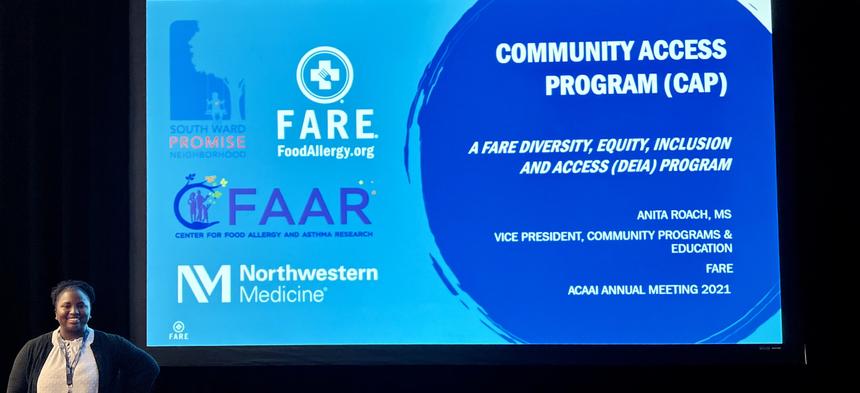ACAAI 2021: Highlights From the Annual Meeting for the American College of Allergy, Asthma & Immunology
Recent findings on food allergy management and prevention emphasize the importance of education and training for community members and healthcare providers.

The annual meeting of the American College of Allergy, Asthma & Immunology was held November 4-8, 2021, in New Orleans, La. This meeting featured hundreds of research presentations, many of which provided noteworthy new findings in the field of food allergy. FARE staff attended the conference along with other allergists, immunologists, researchers and healthcare providers. Here, Jenna Yost, an Education and Health Manager with FARE, summarizes selected conference highlights that feature studies from FARE researchers, collaborating clinicians, and investigators within the FARE Clinical Network.
Access to Food Allergy Support in a Racially Diverse, Low-Income Community Is Lacking

Food allergy disproportionately affects communities of color, as well as low-income populations, who often lack access to specialized diagnostic and treatment care, safe foods and medications. One such community, the South Ward of Newark, N.J., encompasses about 21,000 residents, approximately 91% of whom are Black. One-third are unemployed and roughly 56% of children live in poverty. FARE is partnering with South Ward Promise Neighborhood (SWPN) to identify and address health disparities related to food allergy. In a community survey sent to residents by SWPN in early 2021, 22% reported at least one food allergy in their household. In July 2021, 724 families managing food allergy in the South Ward completed a survey assessing diagnosis and management of food allergies. The following survey findings were presented by Anita Roach, MS, FARE’s Vice President of Community Programs and Education:
- The data regarding epinephrine access and usage was alarming. Just 12% reported having access to epinephrine within 5 minutes compared to the national average of 51%. More than one-third of respondents reported that they were not prescribed epinephrine at all, and 15% reported they had a prescription but did not fill it, the number one reason being that they did not believe they needed it.
- Many respondents reported difficulty accessing allergen safe food, the top reasons being cost (27%) and lack of availability of safe food in the community (22%). A majority (70%) of respondents reported utilizing a food pantry in the previous 12 months, but only one-third reported that food pantry reliably offered allergy-friendly substitutes.
- There were also some worrisome misconceptions about food allergy. Two-thirds of respondents believed that antihistamines, like Benadryl®, can stop a severe allergic reaction, and half believed peanut allergy is more severe than other food allergies.
This survey has helped FARE to identify significant areas of disparate impact caused by food allergy in the South Ward. FARE is working with SWPN and other community partners to address these areas of concern through educational workshops, trainings, support groups, and more.
Solving the Puzzle of Food Allergy Prevention
In this session, scientists and clinicians came together to review the most recent research on food allergy prevention. Foundational research from the LEAP (Learning Early About Peanut Allergy) study in 2015 provided evidence for the support of early introduction of peanuts into a child’s diet to prevent development of peanut allergy. In reaction to this research, the National Institute of Allergy and Infectious Diseases (NIAID) published new guidelines in 2017 that promote the introduction of peanut foods to infants as early as four to six months. But when and how should parents introduce the other most common food allergens?

Carina Venter, PhD, a registered dietitian and co-instructor for FARE's pediatric food allergy course for health professionals, supports expanding early introduction to include as many other foods as possible. Her presentation at ACAAI 2021 emphasized the importance of early childhood diet diversity in food allergy prevention and reviewed research that details how early life nutrition affects gut microbiome development. Dr. Venter and colleagues currently have a paper under review for publication that demonstrates how increased fiber and decreased fat intake can lead to less immune hypersensitivity. Based on her research, “diversity breads diversity,” that is, introducing an increased number of foods into a child’s diet early-on leads to a more diverse microbiome and decreased likelihood of developing food allergies, asthma and eczema.
Dr. Venter’s findings support the need for more research about the role of early introduction of multiple foods in food allergy prevention. To address this, FARE is partnering with Dr. Ruchi Gupta and her team at Northwestern University’s Feinberg School of Medicine to launch the Starting Eating Early Diet (SEED) study. The SEED study will expand on the research from the LEAP study to explore the effects of early introduction of peanut, egg, cow’s milk, cashew, walnut, soy, almond and sesame on preventing the development of food allergy in infants and young children. This research will have important implications for the introduction of common food allergens beyond peanut and possibly provide data to influence introduction guidelines for these foods.
Implementing Early Introduction Guidance: Pediatricians vs. Allergists

Ruchi Gupta, MD, PhD, a practicing pediatrician and FARE's Chief Medical Officer for Public Health, shared results from her team’s research about how clinicians are implementing the new NIAID peanut introduction guidelines. While almost all pediatricians reported using the new peanut introduction guidelines in some capacity, pediatricians were 30% more likely than allergists to deviate from implementing the guidelines exactly as published. In fact, less than a third of pediatricians reported consistently conforming to the published guidelines. Concerns about allergic reactions and about understanding or correctly applying the guidelines were the top two reported barriers to guideline implementation.
To reinforce pediatrician training about food allergy and early introduction, Dr. Gupta and colleagues launched the iREACH (Intervention to Reduce Early (Peanut) Allergy in Children) study to examine if educational modules for pediatricians, in combination with virtual nudges in a patient’s electronic medical record, will prompt pediatricians to give early introduction advice to parents at their 4- and 6-month visits. Encouragingly, preliminary data from this study revealed that clinics that implemented the iREACH nudges experienced higher guideline adherence. Allergists, who were polled by the research team about barriers to guideline implementation, reported their top concern was a lack of referrals. Considering that a large majority of patient referrals come from pediatricians (88%), the lack of a smooth transition from pediatrician to allergist could represent a source of disconnect in a child’s food allergy care journey. Given that about 66% of pediatricians report wanting more training on the topic, pediatrician education surrounding food allergy and early introduction may be the key to improving guideline implementation and increasing referrals to allergists.
Epinephrine Hesitancy: What Happened to Epi First – Epi Fast?

Julie Wang, MD, a practicing pediatrician and FARE Clinical Network investigator with the Icahn School of Medicine at Mount Sinai, delivered a presentation regarding hesitancy toward epinephrine use among allergic patients, allergy families and clinicians. She cited research by Laura Miles and colleagues (2021) that highlights the underuse of epinephrine both inside and outside hospital settings and the disparate administration of epinephrine to adults (7%) versus children (13%) outside the hospital. Dr. Wang provided an overview of her research this past year that explored the origin of hesitancy in epinephrine use. Caregivers reported that the number one reason for not administering epinephrine was because the reaction did not seem severe enough, indicating a lack of understanding about what symptoms constitute an anaphylactic episode.
Unfortunately, lack of consensus around anaphylaxis also exists among clinicians. Dr. Wang presented data from a survey of pediatricians and allergists that describes different scenarios of patients having an allergic reaction. Allergists only came to 100% consensus on whether the scenario represented anaphylaxis or not in one out of 10 cases and pediatricians did not have 100% agreement on any of the scenarios presented. In addition to Dr. Wang, other allergy experts who spoke during this panel session made similar points. There is not one formal definition of anaphylaxis and accredited organizations such as NIAID, World Allergy Organization (WAO), World Health Organization (WHO), and ACAAI all have slightly different criteria for what constitutes an anaphylactic reaction. Therefore, clinicians do not always agree on the diagnosis of anaphylaxis nor the use of epinephrine, and until clinicians and researchers align on a single definition, confusion around decisions to administer epinephrine will persist. These experts encourage increased research to determine age-specific, accessible strategies for overcoming barriers to epinephrine administration.


